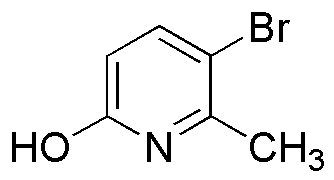3-Bromo-6-hydroxy-2-methylpyridine is widely utilized in research focused on:
- Pharmaceutical Development: This compound serves as a key intermediate in the synthesis of various pharmaceuticals, particularly those targeting neurological disorders. Its unique structure allows for modifications that enhance drug efficacy.
- Agricultural Chemistry: It is used in the formulation of agrochemicals, including herbicides and fungicides, providing effective solutions for crop protection while minimizing environmental impact.
- Material Science: This chemical can be incorporated into polymers to improve their thermal and mechanical properties, making it valuable in the production of high-performance materials.
- Organic Synthesis: Researchers utilize it as a building block in organic synthesis, facilitating the creation of complex molecules in a more efficient manner compared to traditional methods.
- Analytical Chemistry: It is employed as a reagent in various analytical techniques, aiding in the detection and quantification of other compounds, which is essential for quality control in manufacturing.
Informations générales
Propriétés
Sécurité et réglementation
Applications
3-Bromo-6-hydroxy-2-methylpyridine is widely utilized in research focused on:
- Pharmaceutical Development: This compound serves as a key intermediate in the synthesis of various pharmaceuticals, particularly those targeting neurological disorders. Its unique structure allows for modifications that enhance drug efficacy.
- Agricultural Chemistry: It is used in the formulation of agrochemicals, including herbicides and fungicides, providing effective solutions for crop protection while minimizing environmental impact.
- Material Science: This chemical can be incorporated into polymers to improve their thermal and mechanical properties, making it valuable in the production of high-performance materials.
- Organic Synthesis: Researchers utilize it as a building block in organic synthesis, facilitating the creation of complex molecules in a more efficient manner compared to traditional methods.
- Analytical Chemistry: It is employed as a reagent in various analytical techniques, aiding in the detection and quantification of other compounds, which is essential for quality control in manufacturing.
Documents
Fiches de données de sécurité (FDS)
La FDS fournit des informations de sécurité complètes sur la manipulation, le stockage et l’élimination du produit.
Spécifications du produit (PS)
Le PS fournit une description complète des propriétés du produit, notamment sa composition chimique, son état physique, sa pureté et les exigences de stockage. Il détaille également les plages de qualité acceptables et les applications prévues du produit.
Certificats d'analyse (COA)
Recherchez des certificats d'analyse (COA) en saisissant le numéro de lot du produit. Les numéros de lot et de lot se trouvent sur l'étiquette d'un produit, après les mots « Lot » ou « Lot de fabrication ».
Numéro de catalogue
Numéro de lot/série
Certificats d'origine (COO)
Ce certificat d'exploitation confirme le pays dans lequel le produit a été fabriqué, et détaille également les matériaux et composants utilisés et s'il est issu de sources naturelles, synthétiques ou autres sources spécifiques. Ce certificat peut être requis pour les douanes, le commerce et la conformité réglementaire.
Numéro de catalogue
Numéro de lot/série
Fiches de données de sécurité (FDS)
La FDS fournit des informations de sécurité complètes sur la manipulation, le stockage et l’élimination du produit.
DownloadSpécifications du produit (PS)
Le PS fournit une description complète des propriétés du produit, notamment sa composition chimique, son état physique, sa pureté et les exigences de stockage. Il détaille également les plages de qualité acceptables et les applications prévues du produit.
DownloadCertificats d'analyse (COA)
Recherchez des certificats d'analyse (COA) en saisissant le numéro de lot du produit. Les numéros de lot et de lot se trouvent sur l'étiquette d'un produit, après les mots « Lot » ou « Lot de fabrication ».
Numéro de catalogue
Numéro de lot/série
Certificats d'origine (COO)
Ce certificat d'exploitation confirme le pays dans lequel le produit a été fabriqué, et détaille également les matériaux et composants utilisés et s'il est issu de sources naturelles, synthétiques ou autres sources spécifiques. Ce certificat peut être requis pour les douanes, le commerce et la conformité réglementaire.


